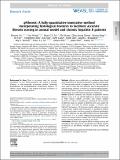| dc.contributor.author | Xu, Shuoyu | |
| dc.contributor.author | Wang, Yan | |
| dc.contributor.author | Tai, Dean C.S. | |
| dc.contributor.author | Wang, Shi | |
| dc.contributor.author | Cheng, Chee Leong | |
| dc.contributor.author | Peng, Qiwen | |
| dc.contributor.author | Yan, Jie | |
| dc.contributor.author | Chen, Yongpeng | |
| dc.contributor.author | Sun, Jian | |
| dc.contributor.author | Liang, Xieer | |
| dc.contributor.author | Zhu, Youfu | |
| dc.contributor.author | Welsch, Roy E. | |
| dc.contributor.author | Wee, Aileen | |
| dc.contributor.author | Hou, Jinlin | |
| dc.contributor.author | Yu, Hanry | |
| dc.contributor.author | Rajapakse, Jagath | |
| dc.contributor.author | So, Peter T. C. | |
| dc.date.accessioned | 2014-06-30T18:42:05Z | |
| dc.date.available | 2014-06-30T18:42:05Z | |
| dc.date.issued | 2014-02 | |
| dc.date.submitted | 2014-02 | |
| dc.identifier.issn | 01688278 | |
| dc.identifier.uri | http://hdl.handle.net/1721.1/88148 | |
| dc.description.abstract | Background & Aims:
There is increasing need for accurate assessment of liver fibrosis/cirrhosis. We aimed to develop qFibrosis, a fully-automated assessment method combining quantification of histopathological architectural features, to address unmet needs in core biopsy evaluation of fibrosis in chronic hepatitis B (CHB) patients.
Methods:
qFibrosis was established as a combined index based on 87 parameters of architectural features. Images acquired from 25 Thioacetamide-treated rat samples and 162 CHB core biopsies were used to train and test qFibrosis and to demonstrate its reproducibility. qFibrosis scoring was analyzed employing Metavir and Ishak fibrosis staging as standard references, and collagen proportionate area (CPA) measurement for comparison.
Results:
qFibrosis faithfully and reliably recapitulates Metavir fibrosis scores, as it can identify differences between all stages in both animal samples (p <0.001) and human biopsies (p <0.05). It is robust to sampling size, allowing for discrimination of different stages in samples of different sizes (area under the curve (AUC): 0.93–0.99 for animal samples: 1–16 mm[superscript 2]; AUC: 0.84–0.97 for biopsies: 10–44 mm in length). qFibrosis can significantly predict staging underestimation in suboptimal biopsies (<15 mm) and under- and over-scoring by different pathologists (p <0.001). qFibrosis can also differentiate between Ishak stages 5 and 6 (AUC: 0.73, p = 0.008), suggesting the possibility of monitoring intra-stage cirrhosis changes. Best of all, qFibrosis demonstrates superior performance to CPA on all counts.
Conclusions:
qFibrosis can improve fibrosis scoring accuracy and throughput, thus allowing for reproducible and reliable analysis of efficacies of anti-fibrotic therapies in clinical research and practice. | en_US |
| dc.description.sponsorship | Janssen Pharmaceutical Ltd. | en_US |
| dc.description.sponsorship | Singapore-MIT Alliance for Research and Technology | en_US |
| dc.language.iso | en_US | |
| dc.publisher | Elsevier | en_US |
| dc.relation.isversionof | http://dx.doi.org/10.1016/j.jhep.2014.02.015 | en_US |
| dc.rights | Article is made available in accordance with the publisher's policy and may be subject to US copyright law. Please refer to the publisher's site for terms of use. | en_US |
| dc.source | Elsevier Open Access | en_US |
| dc.title | qFibrosis: A fully-quantitative innovative method incorporating histological features to facilitate accurate fibrosis scoring in animal model and chronic hepatitis B patients | en_US |
| dc.type | Article | en_US |
| dc.identifier.citation | Xu, Shuoyu, Yan Wang, Dean C.S. Tai, Shi Wang, Chee Leong Cheng, Qiwen Peng, Jie Yan, et al. “qFibrosis: A Fully-Quantitative Innovative Method Incorporating Histological Features to Facilitate Accurate Fibrosis Scoring in Animal Model and Chronic Hepatitis B Patients.” Journal of Hepatology (February 2014). © 2014 European Association for the Study of the Liver | en_US |
| dc.contributor.department | Massachusetts Institute of Technology. Department of Biological Engineering | en_US |
| dc.contributor.department | Massachusetts Institute of Technology. Department of Mechanical Engineering | en_US |
| dc.contributor.department | Sloan School of Management | en_US |
| dc.contributor.mitauthor | Rajapakse, Jagath | en_US |
| dc.contributor.mitauthor | Welsch, Roy E. | en_US |
| dc.contributor.mitauthor | So, Peter T. C. | en_US |
| dc.contributor.mitauthor | Yu, Hanry | en_US |
| dc.relation.journal | Journal of Hepatology | en_US |
| dc.eprint.version | Final published version | en_US |
| dc.type.uri | http://purl.org/eprint/type/JournalArticle | en_US |
| eprint.status | http://purl.org/eprint/status/PeerReviewed | en_US |
| dspace.orderedauthors | Xu, Shuoyu; Wang, Yan; Tai, Dean C.S.; Wang, Shi; Cheng, Chee Leong; Peng, Qiwen; Yan, Jie; Chen, Yongpeng; Sun, Jian; Liang, Xieer; Zhu, Youfu; Rajapakse, Jagath C.; Welsch, Roy E.; So, Peter T.C.; Wee, Aileen; Hou, Jinlin; Yu, Hanry | en_US |
| dc.identifier.orcid | https://orcid.org/0000-0002-0339-3685 | |
| dc.identifier.orcid | https://orcid.org/0000-0002-9038-1622 | |
| dc.identifier.orcid | https://orcid.org/0000-0003-4698-6488 | |
| mit.license | PUBLISHER_POLICY | en_US |
| mit.metadata.status | Complete | |
